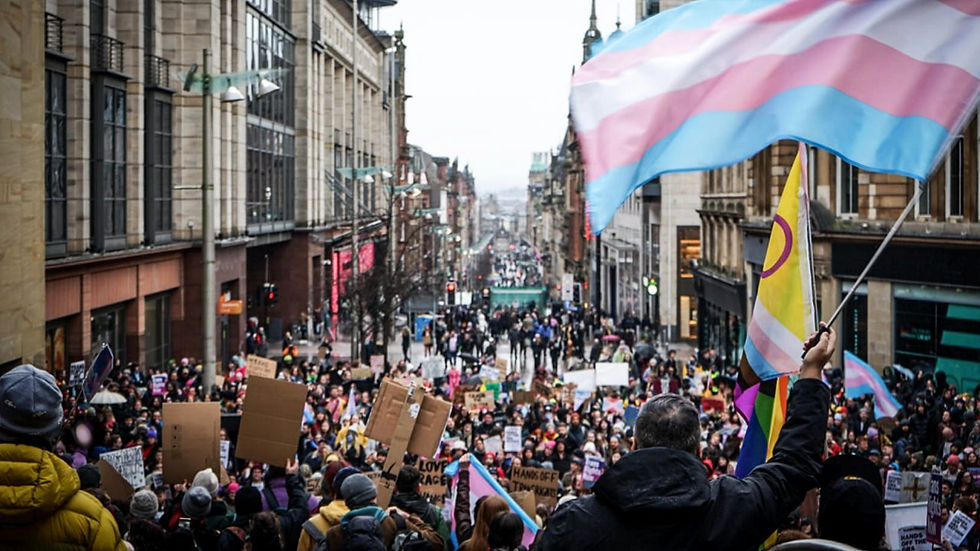"Here, Queer and Living in Fear" - The challenges of being a queer therapist in 2023
- kevynhopkinshall
- May 9, 2023
- 4 min read
Updated: May 15, 2023
“We’re here, we’re queer and we’re living in fear!” This was one of the harrowing chants that could be heard in January during protests against Westminster’s rejection of the Scottish Parliaments Gender Reform Bill. More than being witty or catchy, it was a truth that really resonated with me as a queer person and a queer therapist working with, among other people, queer clients.

This was only recently amplified with most political parties in the UK leaning towards a change in the Equalities Human Rights Commission’s (EHRC) definition of sex to be “biological sex”. And lets not forget looking across the Atlantic at some of the laws and bills being passed in the United States. I have said it’s felt like being on the edge of a precipice about to be pushed over, but at this stage it feel like we are already falling. Even as I write this, I can feel a knot in my stomach of dread, and, as the chant said, fear.
I have worked with a number of clients of diverse identities, whether that be gender, sexuality or relationship orientated diversities. With that, as a queer therapist, there can be a greater or lesser degree of recognition of self in my clients.
One of the challenges as a queer therapist, particularly working with queer clients, is that some clients are often looking for a certain type of therapist they feel relate to their lived experiences.
This leads to referrals and therapist profiles that discloses the therapist’s identity, whether it be their gender identity, their sexuality, relationship preferences and even their relationship status to a degree if this includes polyamory or consensual non-monogamy. This information, when on directories, is by design, easily accessible, so potential clients can find the right therapist for them. For example, I am on Pink Therapy’s directory, a well known and high quality directory of queer therapists. Just by being on there I elude to the fact I don’t align with the cis-heteronormative framework. This isn’t a requirement for being on the directory, but is often the case. On there I also give that I am queer, gay and gender non-conforming, which I share here also, as anyone can find that.
Something I have had to spend some time looking at is how that affects me, it’s a level of openness that I don’t include in much of my everyday. I don’t go out of my way to hide any aspect of it, I have He/They pronouns on my emails etc, I mention my husband rather than my partner, but in these situations, I have control over who can see/hear that information, I choose who I send and say these things too. With therapist profiles, as I have said, it is by it’s very nature, widely accessible. When first putting them together, I thought about how vulnerable it made me feel and how I struggled with the comfort of having that information available, and though felt this was manageable for me, and I happily shared this, it's still something I remain aware of. But as I have watched the news and seen the current climate shift to what feels like one of less tolerance, I have had to spend time revisiting how I feel. For the time being, I feel able to remain as visible, but I keep vigilant of what impact it has on me.

Being online and on social media, particularly as I do read articles about queer experience, means that I end up seeing more of it that can sometime be absorbed. By this I mean, the influence of the dreaded algorithm. Many of us will have experienced having looked up chairs or clothes or insurance, and then for weeks, all you see are ads that show you more of the same. When you click on them, whether intentionally or accidentally as is often the case with me, you reinforce the algorithm and it can feel like you can’t get away. I ended up seeing a couple of clips a tv show on Tiktok, and after watching them, for days, every third video was to do with that show. The same is true for videos regarding changes in legislation surrounding gender laws and videos on the experience of trans, non-binary, poly-amorous and other queer people. This just pushes you further down the rabbit hole, and feeling unable to escape. What we don't always recognise, is that we can experience what is called vicarious trauma. Through hearing about, and seeing the traumatic experiences others are going through, we in turn can internalise that feeling, which is amplified if it resonates with something in us. As a therapist, it is something we are trained to be aware of when working with clients, and is why we have supervision and often, our own personal therapy. But even as a counsellor, it can take some work to realise where certain feelings and blocks are cropping up from.
Ultimately, I, as any other therapist, am human, A state of being that comes with it's own package of unique challenges, joys, traumas, problems, needs and desires. But, by being human, recognising my of fragility, humanity can capacity for empathy, means I have learnt to walk alongside others as they explore their own "humanness", whatever that means from them. It's why I am a counsellor, and why I always intend to be one.


Comments